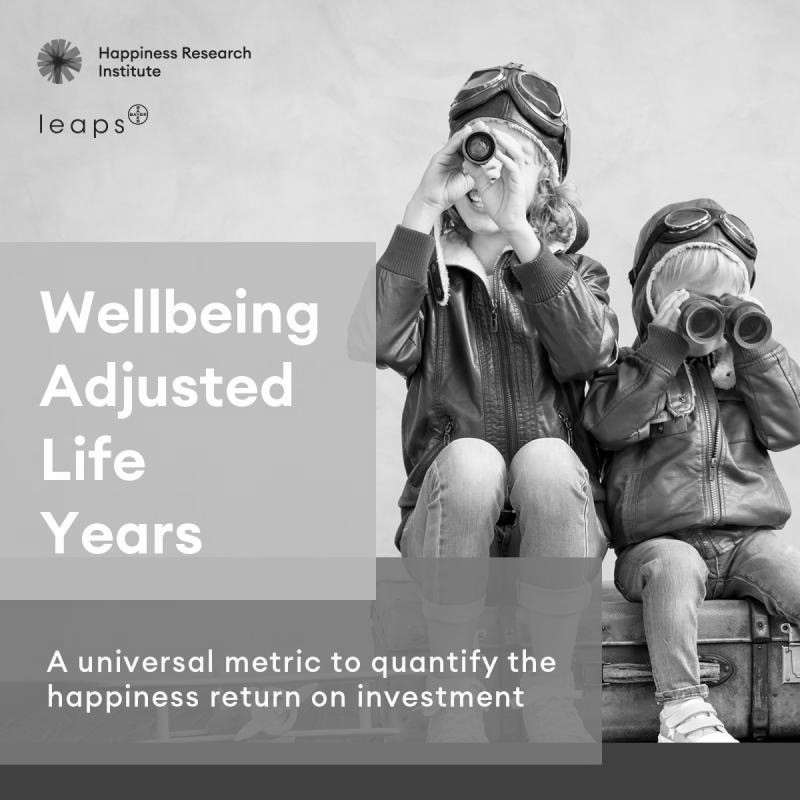In an earlier post, I brought up a metric in health care called Quality Adjusted Life Year, or QALY, which has been used to inform decisions about where to allocate medical resources given differences in potential impact on how much “good life” could be gained. I suggested filmmaking might also benefit from such a metric to gauge the life impact from films to complement metrics about financial return on investment.
I have since come across a similar metric published earlier this year called Well-being Adjusted Life Year, or WALY (see report). This metric was developed by the pharmaceutical company Bayer and their “Leaps” initiative in partnership with the Happiness Research Institute.

In concept, WALYs are similar to QALYs in that both are methods to estimate how much healthy, good life can be gained by intervening in certain ways and how much healthy, good life is lost through factors such as disease. WALYs differ from QALYs, I believe in an important and bettering way, in that they are determined based on measurement of actual life satisfaction, how one assesses their quality of life at a particular time, rather than how people think their lives might be in certain hypothetical or possible situations (e.g., if they were to have a particular disease like diabetes or depression).
Calculation of WALYs is quite simple; it is the ratio of actual well-being to potential well-being, typically using data from responses on a 10-point overall life satisfaction scale.
Using this metric, the developers have reported certain life situations like mental health concerns or inadequate social connections (e.g., loneliness) actually impact well-being more than do most physical health conditions such as asthma and diabetes, proportionally they account for more WALYs lost per individual affected. Then combining amount of impact per individual and number of individuals affected, they can determine number of total WALYs at risk due to particular issues.
The authors conclude their WALY metric can be used by groups and societies in making policy and investment decisions to maximize greatest gains (or protect against greatest losses) in well-being.
Reviewing this report not only reinforced for me the potential utility of such a life-impact metric for film, it also suggested another application of such a metric: to identify which life issues are diminishing well-being the most to help determine where filmmaking efforts might focus for greatest impact.
For example, given the reported negative impact of loneliness on WALYs, which is further supported by recent research that highlights its prevalence and human damage (Leigh-Hunt et al., 2017; Rico-Uribe et al., 2018), films that offer insights to address this issue and to find paths toward solid social connections (one of our 7 core human needs discussed in an earlier post) have the potential to realize great good (and to reach a sizable audience of individuals struggling in this area).
Sadly, I can’t think of a recent film that really captures loneliness and helpful, satisfactory ways to establish solid social connection. What did come to mind were lyrics from “Eleanor Rigby” by The Beatles:
All the lonely people
Where do they all come from?
All the lonely people
Where do they all belong?
What we clearly need are some great films with great insights that help people find where they belong.
References
Leigh-Hunt, N., Bagguley, D., Bash, K., Turner, V., Turnbull, S., Valtorta, N., & Caan, W. (2017). An overview of systematic reviews on the public health consequences of social isolation and loneliness. Public Health, 152, 157-171.
Rico-Uribe, L. A., Caballero, F. F., Martín-María, N., Cabello, M., Ayuso-Mateos, J. L., & Miret, M. (2018). Association of loneliness with all-cause mortality: A meta-analysis. PloS one, 13(1), e0190033.

Gia Kara
September 1, 2020 11:52 pmI love this post and that you took the time to think about those people and brought up the topic. I did a whole presentation in class last year about loneliness and how to fight it. Thanks for highlighting the subject.
Justin B Poll
September 2, 2020 11:54 pmThank you, Gia, for your kind comment. Loneliness is, sadly, such a big issue. It’s been interesting to explore how this issue, and possible insights for alleviating it, could be addressed in film. I’ve tried to do this in “reimagining” a recent sci-fi film, infusing loneliness and ways through it within the existing story (see blog post).